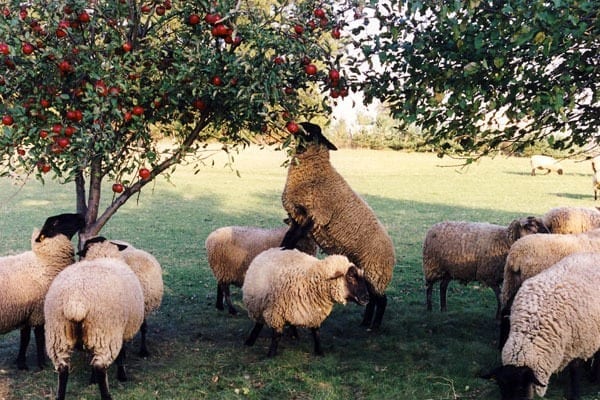
INRA scientists have shown for the first time that the pathogens responsible for scrapie in small ruminants (prions) have the potential to convert the human prion protein from a healthy state to a pathological state.
In mice models reproducing the human species barrier, this prion induces a disease similar to Creutzfeldt-Jakob disease. These primary results published in Nature Communications on 16 December 2014, stress the necessity to reassess the transmission of this disease to humans.
Scrapie is a neurodegenerative disease that has been known for centuries and which affects sheep and goats. Similar to Bovine Spongiform Encephalopathy (BSE) or mad cow disease, scrapie is caused by a transmissible pathogen protein called prion.
However, and contrary to BSE1, epidemiological studies have never been able to establish a link between this disease and the occurrence of prion diseases in humans. “Risks of transmitting scrapie to humans (zoonose) were hitherto considered negligible because of the species barrier that naturally prevents prion propagation between species”, said Olivier Andreoletti, INRA scientist who led the present study.
Researchers at INRA studied the permeability of the human transmission barrier to pathogens responsible for scrapie, using animal models specifically developed for this purpose. This approach previously allowed the confirmation of the zoonotic nature of prions responsible for BSE in cows and of the variant of Creutzfeldt-Jakob disease in humans (vCJD).
Unexpectedly, in these rodent models, certain pathogens responsible for scrapie were able to cross the transmission barrier. Moreover, the pathogens that propagated through this barrier were indistinguishable from the prions causing the sporadic form of Creutzfeldt-Jakob disease (sCJD). This data suggest a potential link between the occurrence of certain sCJD and these animal prions.
“Since CJD is scarce, about 1 case per million and per year, and incubation periods are usually long -several decades- it is extremely difficult for epidemiological studies to try and make this link”, explains Olivier Andreoletti.
Read more: Scrapie could breach the species barrier
The Latest on: Scrapie
[google_news title=”” keyword=”Scrapie” num_posts=”10″ blurb_length=”0″ show_thumb=”left”]
via Google News
The Latest on: Scrapie
- Scientific abstract scrutinizes two human deaths, but there’s no evidence CWD has jumped species barrieron April 25, 2024 at 6:50 am
Nothing about this new report changes current knowledge or guidance on CWD in deer. The evidence remains strong that CWD in deer and elk is not causing disease among hunters who consume infected ...
- 2 die after eating CWD-infected meat: What to know about 'zombie deer disease'on April 24, 2024 at 10:14 am
CWD has never been found in humans, but researchers now believe there may be a risk of the fatal disease spreading after two mysterious deaths.
- Zombie Deer, Prion Disease & Another Dreaded Chemistry Lesson From Hellon April 23, 2024 at 7:08 am
Between COVID, HIV, Dengue, Ebola, and emerging flu variants, the last thing the world needs is another type of pathogen, let alone with no treatment or cure. But, although rare, prion diseases, such ...
- The tech bros' rush for AI riches is foolish, shocking and dangerouson April 23, 2024 at 4:30 am
The proposed solution is foolish, shocking, and dangerous – the use of synthetic data. Firms including Anthropic are addressing the lack of ...
- 7 halal meat outlets closed in Calgary as RCMP investigate unlawful slaughter and saleon April 22, 2024 at 4:38 pm
The list of Calgary halal meat outlets forced to close due to public health orders grew to seven on Monday, as the RCMP announced an investigation into unlawful livestock dealing and illegal slaughter ...
- Calgary halal grocers and wholesaler shut down by Alberta Health Services over sales of uninspected meaton April 22, 2024 at 1:00 am
Investigators with Alberta Health Services served closure orders on four halal grocery stores in Calgary on Friday, and another on a Calgary halal warehouse and distribution centre. The outlets are ...
- CWD findings in deer in Waushara County and Indiana highlight continued spread of diseaseon April 21, 2024 at 4:54 am
CWD findings in deer in Waushara County and Indiana highlight the continued spread of the fatal deer disease, now documented in 33 states.
- Scientists Suggest First Link Between Always-Fatal Deer Disease CWD and Human Deathson April 19, 2024 at 11:51 am
An article published in Volume 102 of 'Neurology' suggests a possible link to CWD as a contributing factor in the deaths of two humans.
- Research Links Parkinson’s and Lewy Body Disease with Chemical Effects on Brain and Guton April 18, 2024 at 9:01 pm
Parkinson’s disease (PD) and certain forms of dementia have been associated with exposure to pesticides, industrial chemicals, and air pollution for decades. But the mechanisms of disease progression ...
- Viral Articles Claim Two ‘Hunters Died After Consuming CWD-Infected Venison.’ Here’s What Really Happenedon April 18, 2024 at 2:22 pm
CJD is a prion disease that affects humans and behaves similarly to CWD and other transmissible spongiform encephalopathies, like mad cow disease in cows and scrapie in sheep. The research abstract ...
via Bing News









